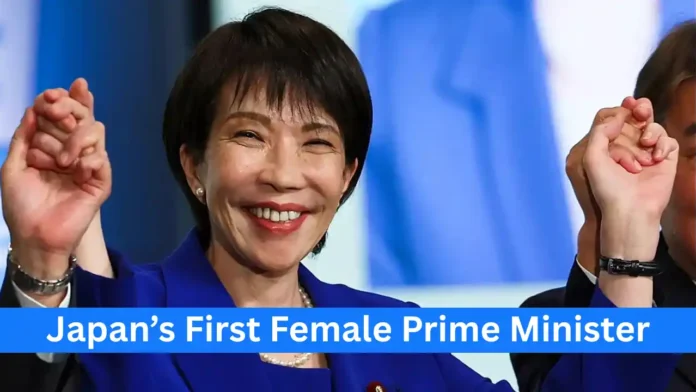Japan has marked a historic milestone with the election of Sanae Takaichi as the leader of the ruling Liberal Democratic Party (LDP), positioning her to become the country’s first female prime minister. On October 4, 2025, Takaichi won a decisive run-off vote against Shinjiro Koizumi, setting the stage for a significant shift in Japan’s leadership and political landscape.
Historic Leadership Victory
Sanae Takaichi secured 185 votes compared to Koizumi’s 156 in a tightly contested LDP leadership race. The outcome follows no candidate achieving a majority in the initial voting round. As the newly elected head of the LDP, Japan’s dominant conservative party, Takaichi is widely expected to succeed outgoing Prime Minister Shigeru Ishiba. The official parliamentary vote to confirm her as prime minister is scheduled for October 15, 2025.
Read Also: Taylor Swift New Album: “Wish List” Lyrics Hint at Travis Kelce Romance
Political Profile and Stance
At 64 years old, Takaichi brings extensive political experience, having served in key cabinet roles including economic security minister. Known for her staunch conservative views, she is aligned with the right-wing faction of the LDP and is recognized for her “Japan First” policy, which mirrors the “America First” approach of former U.S. President Donald Trump. Her leadership symbolizes a blend of nationalist sentiment, economic revitalization ambitions, and a commitment to strengthening Japan’s geopolitical stance.
Policies and National Priorities
Sanae Takaichi has laid out a comprehensive agenda to address Japan’s pressing challenges:
- Economic Security and Innovation: Government investment in cutting-edge sectors such as artificial intelligence, semiconductors, and battery technology.
- Tax Relief and Wage Support: Introduction of tax credits aimed at increasing household take-home pay, alongside proposals for deductions on household services and corporate incentives for in-house childcare.
- Energy Policy: Restarting nuclear power plants to stabilize Japan’s energy supply and reduce reliance on imports.
- National Security: Establishing a panel to scrutinize foreign investments in sensitive industries and enhancing intelligence capabilities.
- Domestic Assistance: Supporting small- and medium-sized enterprises, agriculture, medical and nursing care sectors through subsidies and policy reforms.
Read Also: Chevron El Segundo Refinery Fire Contained in 30 Minutes—No Injuries Reported
Diplomatic Approach and Controversies
Sanae Takaichi’s foreign policy posture is firm yet pragmatic. A vocal critic of China’s military expansion, she is also known for her regular visits to the Yasukuni Shrine — a site commemorating Japan’s war dead, including convicted war criminals, which has strained relations with neighboring South Korea and China. These actions underscore concerns about potential diplomatic tensions but also reflect her commitment to national pride and historical narrative.
Despite her conservative credentials, Sanae Takaichi has pledged to maintain and advance Japan’s alliance with the United States, emphasizing cooperation in security and economic matters. She respects existing bilateral trade agreements and promotes the message that “Japan is Back” on the global stage.
Challenges Ahead
While celebrated as a trailblazer for women in Japanese politics, Takaichi faces substantial hurdles:
- Managing a coalition government without a clear parliamentary majority following recent electoral losses by the LDP.
- Addressing a sluggish economy grappling with inflation, a rapidly aging population, and workforce shortages.
- Reconciling hardline domestic policies with the need for diplomatic balance and regional stability.
- Uniting a party wrestling with internal divisions and restoring public confidence after scandals.
Read Also: Taehyung Celine SS26 Runway Show: BTS V’s Historic Debut at Paris Fashion Week 2025
Conclusion
Sanae Takaichi’s election as the leader of Japan’s Liberal Democratic Party heralds a new era for the country’s leadership. As Japan’s first female prime minister, she represents both historic progress and a continuation of the conservative legacy that has shaped Japan’s postwar politics. Her tenure will be closely watched for how she navigates complex economic, social, and geopolitical challenges while shaping Japan’s future trajectory.
FAQs: Sanae Takaichi as Japan’s First Female Prime Minister
Q: Who is Sanae Takaichi?
A: Sanae Takaichi is a seasoned politician and conservative leader elected as the head of Japan’s ruling Liberal Democratic Party (LDP) in 2025. She is poised to become Japan’s first female prime minister.
Q: When will Sanae Takaichi officially become Japan’s prime minister?
A: The official confirmation vote in Japan’s parliament is expected on October 15, 2025, after which she is likely to assume office.
Q: What are Sanae Takaichi’s main policy priorities?
A: Takaichi prioritizes economic security, government investment in technology sectors like AI and semiconductors, tax credits to boost household income, energy policy including nuclear power restarts, and national security through tighter control of foreign investments.
Q: How did Sanae Takaichi win the leadership election?
A: She won a run-off vote against Shinjiro Koizumi by a margin of 185 to 156 votes within the LDP, becoming the first woman to lead Japan’s dominant conservative party.
Q: What challenges will Sanae Takaichi face as prime minister?
A: She will navigate governing without a parliamentary majority, reviving an underperforming economy, addressing demographic challenges, maintaining diplomatic balance especially with China and South Korea, and uniting a party facing internal divisions.
Q: What is her stance on international relations?
A: Takaichi advocates a “Japan First” approach, aligns strongly with the U.S.-Japan alliance, and has a hawkish stance on regional security, including criticism of China’s military actions. She supports maintaining strong bilateral trade agreements.
Q: Why is Sanae Takaichi’s leadership historically significant?
A: She is Japan’s first female prime minister from the LDP, breaking a longstanding gender barrier in the country’s political leadership.
Q: How does Sanae Takaichi view Japan’s World War II legacy?
A: She maintains nationalist views, has visited the controversial Yasukuni Shrine multiple times, and holds hawkish perspectives on historical issues related to Japan’s wartime past.
Q: What economic measures has she proposed?
A: Proposals include tax credits for households, subsidies for small businesses and agriculture, abolishing extra gasoline taxes, and government-led crisis management investments in key technology sectors.


